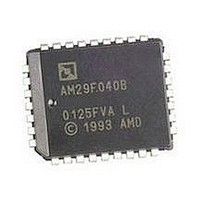AM29F002BT-90JC Spansion Inc., AM29F002BT-90JC Datasheet - Page 20

AM29F002BT-90JC
Manufacturer Part Number
AM29F002BT-90JC
Description
Flash Memory IC
Manufacturer
Spansion Inc.
Datasheet
1.AM29F002BT-90JC.pdf
(42 pages)
Specifications of AM29F002BT-90JC
Memory Size
2Mbit
Memory Configuration
256K X 8
Ic Interface Type
Parallel
Access Time
90ns
Memory Case Style
PLCC
No. Of Pins
32
Operating Temperature Range
0°C To +70°C
Termination Type
SMD
Available stocks
Company
Part Number
Manufacturer
Quantity
Price
Company:
Part Number:
AM29F002BT-90JC
Manufacturer:
ROHM
Quantity:
6 221
DQ6: Toggle Bit I
Toggle Bit I on DQ6 indicates whether an Embedded
Program or Erase algorithm is in progress or complete,
or whether the device has entered the Erase Suspend
mode. Toggle Bit I may be read at any address, and is
valid after the rising edge of the final WE# pulse in the
command sequence (prior to the program or erase
operation), and during the sector erase time-out.
During an Embedded Program or Erase algorithm
operation, successive read cycles to any address
cause DQ6 to toggle. (The system may use either OE#
or CE# to control the read cycles.) When the operation
is complete, DQ6 stops toggling.
After an erase command sequence is written, if all
sectors selected for erasing are protected, DQ6 toggles
for approximately 100 μs, then returns to reading array
data. If not all selected sectors are protected, the
Embedded Erase algorithm erases the unprotected
sectors, and ignores the selected sectors that are
protected.
The system can use DQ6 and DQ2 together to deter-
mine whether a sector is actively erasing or is erase-
suspended. When the device is actively erasing (that is,
the Embedded Erase algorithm is in progress), DQ6
toggles. When the device enters the Erase Suspend
mode, DQ6 stops toggling. However, the system must
also use DQ2 to determine which sectors are erasing
or erase-suspended. Alternatively, the system can use
DQ7 (see the subsection on DQ7: Data# Polling).
If a program address falls within a protected sector,
DQ6 toggles for approximately 2 µs after the program
command sequence is written, then returns to reading
array data.
DQ6 also toggles during the erase-suspend-program
mode, and stops toggling once the Embedded
Program algorithm is complete.
The Write Operation Status table shows the outputs for
Toggle Bit I on DQ6. Refer to Figure 5 for the toggle bit
algorithm, and to the Toggle Bit Timings figure in the
“AC Characteristics” section for the timing diagram.
The DQ2 vs. DQ6 figure shows the differences
between DQ2 and DQ6 in graphical form. See also the
subsection on DQ2: Toggle Bit II.
DQ2: Toggle Bit II
The “Toggle Bit II” on DQ2, when used with DQ6, indi-
cates whether a particular sector is actively erasing
(that is, the Embedded Erase algorithm is in progress),
or whether that sector is erase-suspended. Toggle Bit
II is valid after the rising edge of the final WE# pulse in
the command sequence.
DQ2 toggles when the system reads at addresses
within those sectors that have been selected for era-
sure. (The system may use either OE# or CE# to
18
Am29F002B/Am29F002NB
D A T A
S H E E T
control the read cycles.) But DQ2 cannot distinguish
whether the sector is actively erasing or is erase-sus-
pended. DQ6, by comparison, indicates whether the
device is actively erasing, or is in Erase Suspend, but
cannot distinguish which sectors are selected for era-
sure. Thus, both status bits are required for sector and
mode information. Refer to Table 6 to compare outputs
for DQ2 and DQ6.
Figure 5 shows the toggle bit algorithm in flowchart
form, and the section “DQ2: Toggle Bit II” explains the
algorithm. See also the DQ6: Toggle Bit I subsection.
Refer to the Toggle Bit Timings figure for the toggle bit
timing diagram. The DQ2 vs. DQ6 figure shows the dif-
ferences between DQ2 and DQ6 in graphical form.
Reading Toggle Bits DQ6/DQ2
Refer to Figure 5 for the following discussion. When-
ever the system initially begins reading toggle bit
status, it must read DQ7–DQ0 at least twice in a row to
determine whether a toggle bit is toggling. Typically, a
system would note and store the value of the toggle bit
after the first read. After the second read, the system
would compare the new value of the toggle bit with the
first. If the toggle bit is not toggling, the device has com-
pleted the program or erase operation. The system can
read array data on DQ7–DQ0 on the following read
cycle.
However, if after the initial two read cycles, the system
determines that the toggle bit is still toggling, the
system also should note whether the value of DQ5 is
high (see the section on DQ5). If it is, the system
should then determine again whether the toggle bit is
toggling, since the toggle bit may have stopped tog-
gling just as DQ5 went high. If the toggle bit is no longer
toggling, the device has successfully completed the
program or erase operation. If it is still toggling, the
device did not complete the operation successfully, and
the system must write the reset command to return to
reading array data.
The remaining scenario is that the system initially
determines that the toggle bit is toggling and DQ5 has
not gone high. The system may continue to monitor the
toggle bit and DQ5 through successive read cycles,
determining the status as described in the previous
paragraph. Alternatively, it may choose to perform
other system tasks. In this case, the system must start
at the beginning of the algorithm when it returns to
determine the status of the operation (top of Figure 5).
DQ5: Exceeded Timing Limits
DQ5 indicates whether the program or erase time has
exceeded a specified internal pulse count limit. Under
these conditions DQ5 produces a “1.” This is a failure
condition that indicates the program or erase cycle was
not successfully completed.
21527D5 November 1, 2006
















